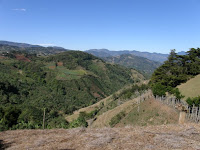
Last week we went to visit a volunteer in San Cristobal Norte. San Cristobal produces and sells chives to Chinese restaurants around the country. What's special about this little town in the hills near Cartago? How did they corner the chive market? Turns out there's nothing special about the soil or altitude. One day a local farmer who grew a few chives noticed chinese families buying his entire crop and realized that there was a large market. Other farmers caught on, increased production, and signed contracts with chinese restaurants near and far.
Economists argue about why certain towns or countries produce certain products. Does Japan export cars because Japan has an inherent comparative advantage in cars? (meaning they have a lower opportunity cost--what they could have produced instead of cars is less that what other countries can produce instead of cars). Or, did Japan do something at some point to gain the comparative advantage in cars--for example, invest in engineering schools, or raise tariffs to protect domestic car markets and give Japanese car companies an advantage until they could compete on the world market? I'm sure this dichotomy depends on the product and country, but San Cristobal Norte developed their comparative advantage in chives.

In San Cristobal we interviewed the president and secretary of Sacrin de Desamparados SA, a microfinance bank founded in 1996. Twenty members of the community came together, put in $200, wrote by-laws, and elected officers. They lent money to community members for agriculture and other businesses. They know the community and require borrowers to find co-signers, and after fourteen years they have yet to write off a bad loan. They offer lower interest rates than banks, offer smaller loans than banks, and require less paperwork. Sacrin turns a generous profit for shareholders--all community members--and has grown to 82 shareholders, $50,000 in capital, and made $200,000 of loans in the last year.
We also had a chance to climb this hill:



Alex,
ReplyDeleteTell me more about the Chinese in Costa Rica... are they there as travelers, or is there a community of Chinese (expats?) in Costa Rica?
Is there Cilantro in Costa Rica??
Happy hiking!
There's a sizeable Chinese population in Costa Rica, and plenty of Chinese restaurants around. Plenty of Tico restaurants serve "Cantonese Rice," too.
ReplyDeleteAnd oh boy is there ever cilantro. In fact, Costa Rica has both the cilantro we're used to and an indigenous type the call Coyote Cilantro which has an even stronger flavor!